Wage and salary earners’ accidents at work
The risk of fatal accidents at work fell clearly
A total of 30 fatal accidents at work occurred to wage and salary earners in 2008. The number of fatal accidents at work fell clearly from the year before, as in 2007 accidents at work resulted in the death of 37 wage and salary earners. It should be noted that accidents in work traffic cannot always be separated from commuting accidents when settling claims. Therefore, some of the accidents that occur in work traffic are recorded as commuting accidents. The number of accidents at work in traffic has decreased from the early 1990s. (Appendix Table 1)
The risk of fatal accidents at work fell clearly. In 2008, an average of 1.4 per 100,000 wage and salary earners died in an accident at work (Figure 1). In 2007, the respective figure was 1.7. This means a drop of almost one-fifth from the previous year in the risk of fatal accidents at work (17.6%). The difference between the genders with regard to fatal accidents at work is still clear: of the 30 fatal accidents at work 29 occurred to men and only one to a woman. Fatal accidents at work took place in certain industries: almost two-thirds occurred in the activities of manufacturing (industry category C), construction (F), wholesale and retail trade (G), and transport, storage and communication (H) (Appendix Table 2). The risk of death at work has been traditionally particularly high in the construction industry. In 2008, there were 3.4 fatal accidents per 100,000 wage and salary earners in construction. In the industry of transport, storage and communication the risk of fatal accidents at work was 3.8. In the activity of wholesale and retail trade, on the average, 2.2 wage and salary earners had a fatal accident at work.
The data by industry are based on the revised Standard Industrial Classification TOL 2008 which was adopted in the Statistics on Accidents at Work in the statistical reference year 2008. The data classified by the revised industrial classification are not comparable with those produced by its predecessor TOL 2002 (this applies to data from reference year 2007 and prior to it).
Figure 1. Wage and salary earners’ fatal accidents at work per 100,000 wage and salary earners in 1996-2008
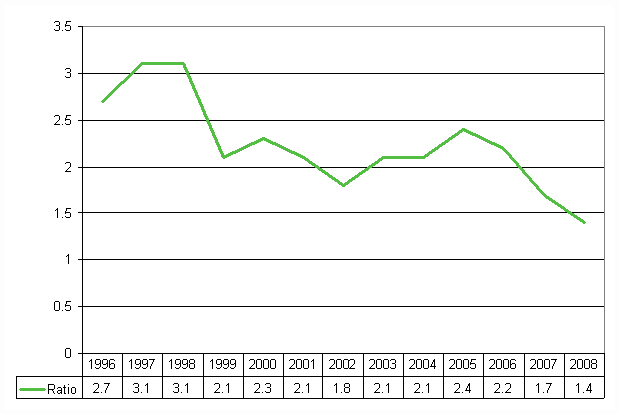
Number and risk of wage and salary earners’ accidents at work fell slightly
The number of wage and salary earners’ accidents at work was slightly lower in 2008 than one year earlier. In 2008, wage and salary earners had 53,960 accidents at work causing disability of at least four days. This was 1,511 fewer than in 2007 (-2.7%). Farmers’ accidents at work decreased by some 300 from the year before, but the number of accidents suffered by other self-employed persons increased slightly (Figure 2). However, it should be noted that accident insurance is voluntary for self-employed persons, so the number of accidents at work may also indicate the popularity of insurance among self-employed persons. It is estimated that around 40 per cent of self-employed persons are insured against accidents at work.
Figure 2. Changes in the number of accidents at work by status in employment in 2000–2008
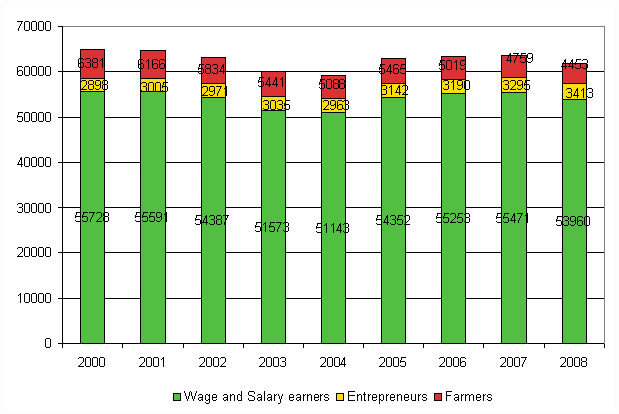
The risk of accidents at work has been falling among Finnish wage and salary earners since the late 1990s (Figure 3). This becomes evident when the number of accidents is expressed proportional to 100,000 wage and salary earners. The accident incidence rate fell by some 14 per cent between 1998 and 2004. In 2008, a total of 2,428 accidents at work resulting in disability of at least four days occurred per 100,000 wage and salary earners. The corresponding ratio in 2007 was 2,530, which means that the risk of accidents at work decreased from 2007 (-4.0%).
Figure 3. Accidents at work per 100,000 salary and wage earners in 1996–2008
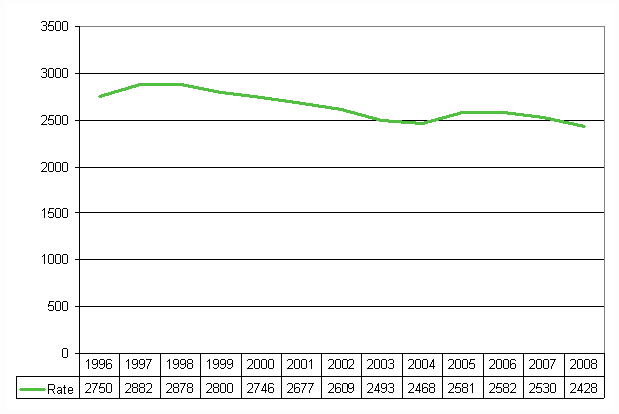
Accidents at work continue to be a problem among men: more than seven in ten accidents at work (72%) occur to men. Men’s risk of accidents at work has traditionally been clearly higher than women’s. Measured with the accident incidence rate, men’s risk of suffering accidents at work is more than 2.5 times that of women’s. The key reason for this is that more men than women work in industries and have jobs with a higher than average risk of accidents at work.
Table 1. Wage and salary earners' accidents at work by gender and age in 2008
| Age | Total | Males | Females | |||
| N | % | N | % | N | % | |
| Total | 53 960 | 100 | 38 711 | 100 | 15 249 | 100 |
| 15–24 | 7 750 | 14,4 | 5 770 | 14,9 | 1 980 | 13,0 |
| 25–34 | 12 040 | 22,3 | 9 200 | 23,8 | 2 840 | 18,6 |
| 35–44 | 12 319 | 22,8 | 9 043 | 23,4 | 3 276 | 21,5 |
| 45–54 | 13 320 | 24,7 | 9 235 | 23,9 | 4 085 | 26,8 |
| 55–64 | 8 290 | 15,4 | 5 282 | 13,6 | 3 008 | 19,7 |
| Others | 241 | 0,4 | 181 | 0,5 | 60 | 0,4 |
Men's risk of accidents at work is highest among the youngest age group (aged 15 to 24). In 2008, young men had 4,215 accidents at work resulting in at least four days’ absence from work per 100,000 wage and salary earners (Figure 2). This meant than the risk measured with the accident incidence rate was 20 per cent higher than the average for wage and salary earner men. Young men’s, as well as all wage and salary earner men’s risk of accidents diminished from the previous year (by -6.6% and 6.2% respectively). Unlike men’s, women's risk of accidents is the highest among the oldest age group of 55 to 64-year-olds. However, differences between age groups are fairly small among women. All in all, the risk declines almost steadily with increasing age. The picture of the accidents at work situation by gender given by the accident incidence rate has remained almost unchanged from one year to the next.
Figure 4. Wage and salary earners’ accidents at work per 100,000 wage and salary earners by gender and age in 2008
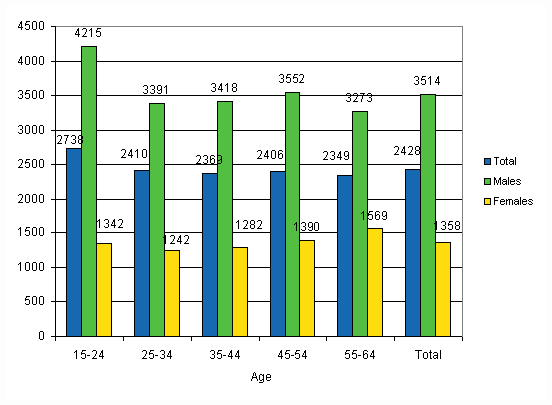
Building construction is still the riskiest
In 2008, the industries with a high risk of accidents at work when measured with accident frequency were manufacture of wood and wood products (37.9), construction (35.4) and manufacture of fabricated metal products (35.2). Figure 5 lists the industries with a higher than average (15.1) accident frequency. The frequencies have been calculated from accidents at work resulting in disability of at least four days, fatal accidents excluded. Municipal sector employees have been classified into their own category, as information on their industry is missing from the accidents at work data files. Wage and salary earners in the municipal sector had 10.2 accidents at work per one million hours worked in 2008, while one year earlier their accident frequency was 9.8.
Figure 5. Wage and salary earners’ accidents at work per one million working hours by branch of industry in 2008, accident frequency higher than average
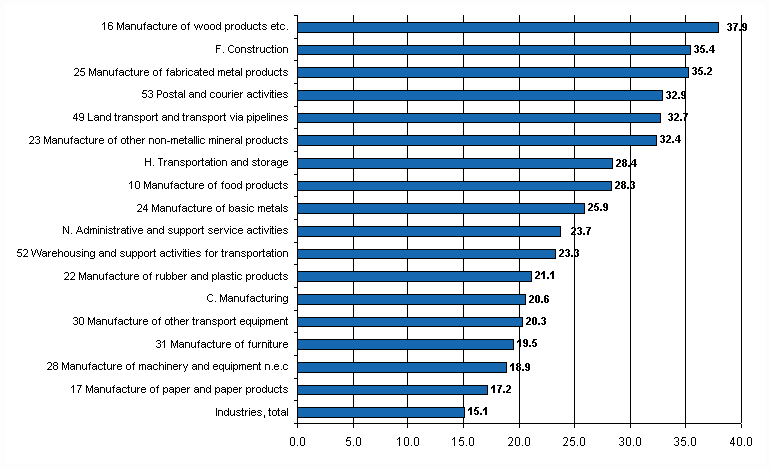
Whether measured with accident incidence rate or accident frequency the risk of accidents at work shows a clear decline since the late 1990. In the previous reference year of 2007 the overall accident frequency for all industries was 15.9.
An examination by occupation (Figure 6) shows that the accident risk continues to be highest in the occupational group of building construction, where it is roughly four times as high as the average. In 2008, building construction workers had 10,330 accidents at work resulting in disability of at least four days per 100,000 wage and salary earners. One year earlier the same accident incidence rate was 10,906. Measured with the accident incidence rate, the accident risk in building construction work fell by five per cent or so (-5.3%).
Building construction work was followed by food processing work (7,883), agricultural work (6,912) and wood processing work (6,747). Figure 6 lists the occupational groups with a higher than average risk of accidents at work. The average number of accidents at work resulting in disability of at least four days per 100,000 wage and salary earners was 2,428. As in the years before, the number of accidents at work was highest in various occupational groups in manufacturing.
Figure 6. Wage and salary earners’ accidents at work per 100,000 wage and salary earners by occupation in 2008, accident rate higher than average
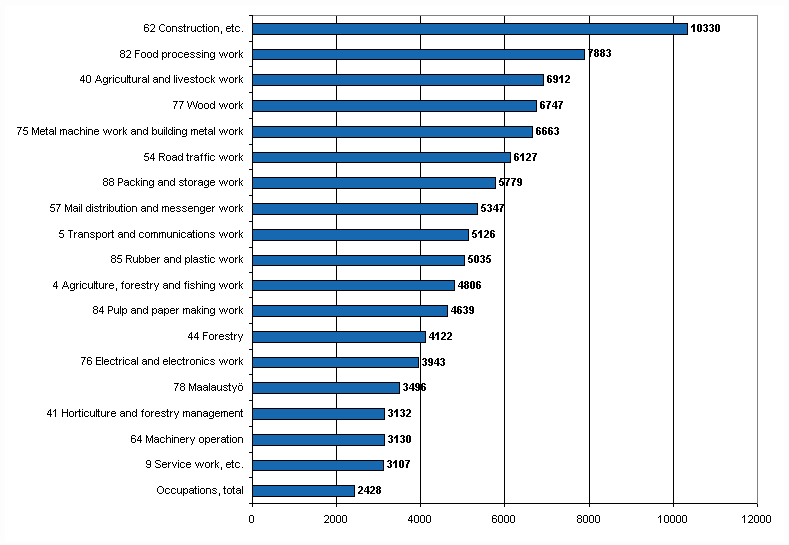
The accident frequency is a more accurate measure of risk than the accident incidence rate, as it expresses the number of accidents as a proportion of the time (hours worked) during which wage and salary earners have been exposed to accidents at work. The hours worked, that is, the time of being exposed to accidents at work can, however, vary from person to person.
Previously Statistics Finland’s occupational accident statistics calculated the accident incidence rate by expressing the accidents at work resulting in at least three days' absence from work as a proportion of 1,000 wage and salary earners. The parameters have been harmonised nationally and with Eurostat’s practice. The accident incidence rate is now expressed as the number of accidents at work resulting in disability of at least four days per 100,000 persons in the reference population. The accident frequency is expressed as the proportion of accidents at work resulting in at least four days' absence from work of one million hours worked. The data on the number of wage and salary earners and their hours worked are obtained from Statistics Finland’s Labour Force Survey.
ESAW variables describing the circumstances and manner of accidents at work among wage and salary earners
In 2003, a revised form for reporting accidents at work was introduced in Finland and used for the first time to collect data on the circumstances and manner of accidents at work consistent with the European Statistics on Accidents at Work (ESAW). These data are now published for the sixth time in Statistics Finland’s occupational accident statistics for 2008. Compared with the previous year’s statistics the distributions of the variables are similar and thus appear fairly reliable. Eurostat’s project is ambitious and the data to be collected are quite detailed in places, which is why the data presented here provide a comprehensive picture of the circumstances having prevailed when the accidents at work took place as well as of their causes and consequences.
The Member States are allowed to exercise discretion as to the scope of their data collection. In Finland the data on accidents at work are collected by the key ESAW variables, and for some of them data are collected at the main category level only. The data are presented according to the incidence process of the accident at work, so that the prevailing circumstances are described first, then the progress of the event and finally the consequences of the accident. Categories have been combined in some of the variables due to presentation reasons. The text section presents mainly distributions by gender and in the appended table section distributions by other background variables, such as industry and occupation. In addition to this, data are given only on the basis of the national classification. Such data are e.g. the data on the variable describing the direct cause of the accident at work (see Table 7). An indication that they are in line with the joint European statistics on accidents at work is given in tables and figures based on ESAW statistics.
Most accidents occur when the person is moving
Data are first given about the general circumstances prior to the accident at work. The first ESAW variable describes the working process the wage and salary earner was involved in when the accident occurred. However, the working process does not refer the person’s occupation, because the tasks may vary at different times in the same occupation. Slightly over one-third (33.9%) of men’s accidents at work occurred in working processes related to production, manufacturing, processing or storing. In relative terms, women had the most (46.5%) accidents in working processes related to public or private services (Table 2).
Table 2. Wage and salary earners’ accidents at work by gender and working process in 2008
| Working process | Total | Males | Females | |||
| N | % | N | % | N | % | |
| Total | 53 960 | 100 | 38 711 | 100 | 15 249 | 100 |
| 10 Production, manufacturing, processing, storing | 15 839 | 29,4 | 13 119 | 33,9 | 2 720 | 17,8 |
| 20 Excavation, construction, repair, demolition | 5 420 | 10,0 | 5 288 | 13,7 | 126 | 0,8 |
| 30 Agricultural type work, forestry, horticulture, fish farming, work with live animals | 1 553 | 2,9 | 903 | 2,2 | 649 | 4,3 |
| 40 Services provided to enterprise and/or to the general public; intellectual activity | 9 320 | 17,2 | 2 224 | 5,7 | 7 096 | 46,5 |
| 50 Other work related to tasks coded under 10, 20, 30 and 40 | 11 136 | 20,6 | 9 107 | 23,5 | 2 029 | 13,4 |
| 60 Movement, sport, artistic activity | 8 130 | 15,1 | 6 116 | 15,9 | 2 014 | 13,3 |
| 99 Other Working Processes no listed above | 965 | 1,8 | 652 | 1,7 | 313 | 2,1 |
| 00 No information | 1 597 | 3,0 | 1 302 | 3,4 | 295 | 1,9 |
The specific physical activity illustrates the person’s exact physical activity just before the moment of injury, while the working process variable describes the general nature of work at the time of the accident. The specific physical activity can be intentional or voluntary, but it need not be of long duration. According to the results (Table 3), more than every third accident occurred when the person was moving. More of women’s accidents (43.5%) took place in connection with movement than men’s (32.3%). Nearly every fifth (18.6%) accident occurred when the person was carrying a load by hand. Likewise, around one-fifth (19.8%) of accidents took place when handling diverse objects. In relative terms, men had over 50 per cent more accidents at work when working with hand-held tools than women did.
Table 3. Wage and salary earners’ accidents at work by gender and specific physical activity in 2008
| Specific physical activity | Total | Males | Females | |||
| N | % | N | % | N | % | |
| Total | 53 960 | 100 | 38 711 | 100 | 15 249 | 100 |
| 10 Operating machine | 2 459 | 4,6 | 2 051 | 5,3 | 408 | 2,7 |
| 20 Working with hand-held tools | 6 744 | 12,5 | 5 757 | 14,9 | 987 | 6,5 |
| 30 Driving/being on board a means of transport or handling equipment | 1 305 | 2,4 | 1 038 | 2,7 | 267 | 1,8 |
| 4 Handling of objects | 10 694 | 19,8 | 7 934 | 20,5 | 2 760 | 18,1 |
| 50 Carrying by hand | 10 061 | 18,6 | 7 059 | 18,2 | 3 002 | 19,7 |
| 60 Movement | 19 143 | 35,5 | 12 507 | 32,3 | 6 636 | 43,5 |
| 70 Presence | 1 235 | 2,3 | 746 | 1,9 | 489 | 3,2 |
| 99 Other Specific Physical Activities not listed above | 1 206 | 2,2 | 759 | 2,0 | 447 | 2,9 |
| 00 No information | 1 113 | 2,1 | 860 | 2,2 | 253 | 1,7 |
The cause of accident mostly stumbling, slipping or falling
Next we will examine the progress of the events leading to the actual accident at work. Among women roughly one-third (34.6%) and among men nearly 30 per cent (28.7%) of accidents at work resulted from stumbling, jumping, slipping or falling (Table 4). The proportions are nearly the same as one year ago. This appears from the data on the “deviation” variable which describes the unusual occurrence during the physical activity leading to the accident at work. If several deviating events precede the actual accident, the one occurring last is recorded. The second most common event leading to an accident was sudden physical stress for both men (18.2%) and women (20.7%).
Table 4. Wage and salary earners’ accidents at work by gender and deviation in 2008
| Deviation | Total | Males | Females | |||
| N | % | N | % | N | % | |
| Total | 53 960 | 100 | 38 711 | 100 | 15 249 | 100 |
| 10 Deviation due to electrical problems, explosion, fire | 134 | 0,2 | 120 | 0,3 | 14 | 0,1 |
| 20 Deviation by overflow, overturn, leak, flow, vaporisation, emission | 1 331 | 2,5 | 1 003 | 2,6 | 328 | 2,2 |
| 30 Breakage, bursting, splitting, slipping, fall, collapse of Material Agent | 6 069 | 11,2 | 4 677 | 12,1 | 1 392 | 9,1 |
| 40 Loss of control (total or partial) of machine, means of transport or handling equipment, hand-held tool, object, animal | 7 408 | 13,7 | 5 793 | 15,0 | 1 615 | 10,6 |
| 50 Slipping – Stumbling and falling – Fall of persons | 16 374 | 30,3 | 11 091 | 28,7 | 5 283 | 34,6 |
| 60 Body movement without any physical stress (generally leading to an external injury) | 8 753 | 16,2 | 6 693 | 17,3 | 2 060 | 13,5 |
| 70 Body movement under or with physical stress (generally leading to an external injury) | 10 221 | 18,9 | 7 059 | 18,2 | 3 162 | 20,7 |
| 80 Shock, fright, violence, aggression, threat, presence | 1 219 | 2,3 | 489 | 1,3 | 730 | 4,8 |
| 99 Other Deviations not listed above | 1 773 | 3,3 | 1 294 | 3,3 | 479 | 3,1 |
| 00 No information | 678 | 1,3 | 492 | 1,3 | 186 | 1,2 |
Roughly three in ten (28.9%) of the victims of accidents at work were injured due to horizontal or vertical impact with or against a stationary object (Table 5). This is also indicated by the data on the variable expressing the deviating situation leading to the accident, where stumbling, falling or similar was the most common event leading to the accident. With a few exceptions, the data on these two variables are almost identical for men and women. Roughly every fourth (24.6%) was injured as a result of sudden physical or mental stress. The mode of injury describes how the injured body part came into contact with the cause of the injury. Where there are several modes of injury, the one causing the most serious injury is recorded.
Table 5. Wage and salary earners’ accidents at work by gender and contact - mode of injury in 2008
| Contact - Mode of injury (ESAW) | Total | Males | Females | |||
| N | % | N | % | N | % | |
| Total | 53 960 | 100 | 38 711 | 100 | 15 249 | 100 |
| 10 Contact with electrical voltage, temperature, hazardous substances | 1 437 | 2,7 | 991 | 2,6 | 446 | 2,9 |
| 20 Drowned, buried, enveloped | 7 | 0,0 | 3 | 0,0 | 4 | 0,0 |
| 30 Horizontal or vertical impact with or against a stationary object (the victim is in motion) | 15 583 | 28,9 | 10 504 | 27,1 | 5 079 | 33,3 |
| 40 Struck by object in motion, collision with | 5 938 | 11,0 | 4 631 | 12,0 | 1 307 | 8,6 |
| 50 Contact with sharp, pointed, rough, coarse Material Agent | 8 380 | 15,5 | 6 642 | 17,2 | 1 738 | 11,4 |
| 60 Trapped, crushed, etc. | 6 085 | 11,3 | 4 686 | 12,1 | 1 399 | 9,2 |
| 70 Physical or mental stress | 13 288 | 24,6 | 9 324 | 24,1 | 3 964 | 26,0 |
| 80 Bite, kick, etc. (animal or human) | 1 044 | 1,9 | 383 | 1,0 | 661 | 4,3 |
| 99 Other Contacts – Modes of Injury not listed in above | 1 818 | 3,4 | 1 273 | 3,3 | 545 | 3,6 |
| 00 No information | 380 | 0,7 | 274 | 0,7 | 106 | 0,7 |
In slightly over 30 per cent of wage and salary earners’ accidents at work the material agent of the injury was various kinds of scaffolding, surfaces and planes, which caused 30.2 per cent of men’s and 36.6 per cent of women’s accidents at work. Different materials, objects and supplies injured slightly over one-quarter of the victims of accidents at work (Table 6).
The data on the material agent of contact describes the physical factor with which the injured body part was in contact. When several modes are involved those filling in the accident notification form are asked to report the material agent of the most serious injury.
Table 6. Wage and salary earners’ accidents at work by gender and material agent of contact - mode of injury in 2008
| Material Agent of Contact-Mode of injury (FAII) 1) | Total | Males | Females | |||
| N | % | N | % | N | % | |
| Total | 53 960 | 100 | 38 711 | 100 | 15 249 | 100 |
| 1100-1399 Scaffolding, surfaces and planes | 17 236 | 31,9 | 11 653 | 30,2 | 5 583 | 36,6 |
| 2100-2799 Tools, machines and equipment | 8 883 | 16,5 | 7 358 | 18,9 | 1 525 | 10,0 |
| 2801-2899 Conveying, transport and storage equipment | 2 930 | 5,4 | 1 980 | 5,1 | 950 | 6,3 |
| 3100, 3200 Transport equipment | 1 558 | 2,9 | 1 286 | 3,3 | 272 | 1,7 |
| 4100-4400 Materials, objects and supplies | 15 040 | 27,9 | 11 668 | 30,1 | 3 372 | 22,1 |
| 5100 Living organisms and human-beings | 2 924 | 5,4 | 991 | 2,6 | 1 933 | 12,7 |
| 5200 Bulk waste | 277 | 0,5 | 213 | 0,6 | 64 | 0,4 |
| 5300 Physical phenomena and natural elements | 428 | 0,8 | 295 | 0,8 | 133 | 0,9 |
| 9999 Other material agents not listed above | 3 579 | 6,6 | 2 473 | 6,4 | 1 106 | 7,3 |
| 0000 No information | 1 105 | 2,0 | 794 | 2,1 | 311 | 2,0 |
The classification describing the material agent is national for the occupational accident data on wage and salary earners. The classification is considerably more detailed than in the past. Two things should be kept in mind when examining the results. First, the occurrence of an accident at work is usually a sum of many factors and no individual material agent can always be identified unambiguously. However, the variable data show what kind of equipment or tools the victim was using or in what kind of working environment the accident occurred. Second, inadequate guidance or inexperience on the part of the worker can often play a major role in the occurrence of an accident. It is difficult and often impossible to produce statistics on such factors.
Four out of ten injuries (41.9%) caused by accidents at work were dislocations, sprains or strains (Table 8). The next most common were wounds and superficial injuries (26.5%) and various concussions and internal injuries (16.2%). Men’s accidents caused relatively more often diverse wounds and superficial injuries, while women’s accidents caused dislocations, sprains and strains. This is consistent with the results presented above, which showed that men more often than women injure themselves in accidents at work in connection with sharp objects whereas women more than men injure themselves by stumbling or slipping.
Table 7. Wage and salary earners’ accidents at work by gender and type of injury in 2008
| Type of Injury (ESAW) | Total | Males | Females | |||
| N | % | N | % | N | % | |
| Total | 53 960 | 100 | 38 711 | 100 | 15 249 | 100 |
| 010 Wounds and superficial injuries | 14 274 | 26,5 | 10 872 | 28,1 | 3 402 | 22,3 |
| 020 Bone fractures | 5 501 | 10,2 | 4 025 | 10,4 | 1 476 | 9,7 |
| 030 Dislocations, sprains and strains | 22 634 | 41,9 | 15 661 | 40,5 | 6 973 | 45,7 |
| 040 Traumatic amputations (Loss of body parts) | 217 | 0,4 | 190 | 0,5 | 27 | 0,2 |
| 050 Concussions and internal injuries | 8 733 | 16,2 | 6 177 | 16,0 | 2 556 | 16,8 |
| 060 Burns, scalds and frostbites | 1 181 | 2,2 | 765 | 2,0 | 416 | 2,7 |
| 070 Poisonings and infections | 156 | 0,3 | 129 | 0,3 | 27 | 0,2 |
| 080 Drowning and asphyxiations | 2 | 0,0 | 2 | 0,0 | - | - |
| 090 Effects of sound, vibration and pressure | 8 | 0,0 | 8 | 0,0 | - | - |
| 100 Effects of temperature extremes, light and radiation | 22 | 0,0 | 18 | 0,0 | 4 | 0,0 |
| 110 Shocks | 117 | 0,2 | 76 | 0,2 | 41 | 0,3 |
| 120 Multiple injuries | 234 | 0,4 | 161 | 0,4 | 73 | 0,5 |
| 999 Other specified injuries not included under other headings | 359 | 0,7 | 266 | 0,7 | 93 | 0,6 |
| 000 No information | 522 | 1,0 | 361 | 0,9 | 161 | 1,1 |
More than four out of ten accidents at work (43.8%) involve the upper extremities (Table 8). Nearly 30 per cent (29.2%) injure lower extremities, including hips, thighs, knees, shins and ankles.
Table 8. Wage and salary earners’ accidents at work by gender and injured body part in 2008
| Part of Body Injured (ESAW) | Total | Males | Females | |||
| N | % | N | % | N | % | |
| Total | 53 960 | 100 | 38 711 | 100 | 15 249 | 100 |
| 10 Head | 2 149 | 4,0 | 1 690 | 4,4 | 459 | 3,0 |
| 20 Neck | 540 | 1,0 | 366 | 0,9 | 174 | 1,1 |
| 30 Back, spine | 7 527 | 13,9 | 5 198 | 13,4 | 2 329 | 15,3 |
| 40 Torso, internal organs | 2 632 | 4,9 | 2 068 | 5,3 | 564 | 3,7 |
| 50 Upper extremities | 23 636 | 43,8 | 17 340 | 44,8 | 6 296 | 41,3 |
| 60 Lower extremities | 15 783 | 29,2 | 11 023 | 28,5 | 4 760 | 31,2 |
| 70 Entire body or several body parts | 1 422 | 2,6 | 841 | 2,2 | 581 | 3,8 |
| 99 Others | 129 | 0,2 | 93 | 0,2 | 36 | 0,2 |
| 00 Data missing | 142 | 0,3 | 92 | 0,2 | 50 | 0,3 |
Average duration of absence from work 12 days
The seriousness of accidents at work can be assessed on the basis of the duration of disability resulting from the injury. The figures describing the length of absence from work before 2002 are not fully comparable with the figures for 2002 to 2008, because it was not previously possible to distinguish the cases leading to an employment accident pension. The cases leading to an employment accident pension are always serious, but in some of the cases the recorded number of days of absence may have been low before the decision on the pension was granted. Now pension cases are excluded from the examination of the duration of disability.
The average duration of absence from work due to an accident at work was 12 (12.2) days in 2008. The average duration of disability was 13.2 days for men and 9.9 days for women. The average duration of absence caused by accidents increased with age for both men and women (Figure 7). Included are also accidents at work leading to disability lasting under four days.
Figure 7. Average length of absence of wage and salary earners' accidents at work by gender and age in 2008
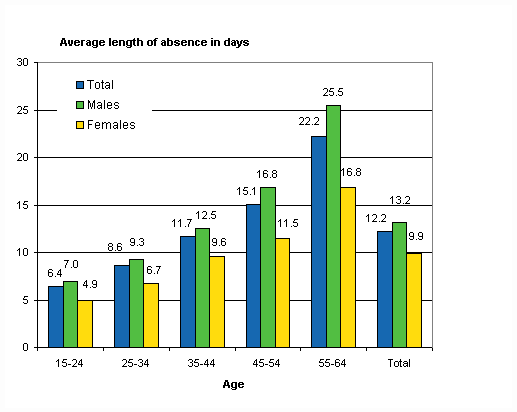
Slightly under one-third (30.1%) of all accidents leading to disability lasting at least four days caused disability of four to six days, and around 17.4 per cent of the accidents – including employment accident pension cases – were serious, causing absences lasting longer than 30 days (Table 9).
Table 9. Wage and salary earners’ accidents at work by gender and length of disability in 2008
| Duration of disability - days | Total | Males | Females | |||
| N | % | N | % | N | % | |
| Total | 53 960 | 100 | 38 711 | 100 | 15 249 | 100 |
| 4–6 days | 16 227 | 30,1 | 11 328 | 29,3 | 4 899 | 32,1 |
| 7–14 days | 19 459 | 36,1 | 13 920 | 36,0 | 5 539 | 36,3 |
| 15–30 days | 8 947 | 16,6 | 6 564 | 17,0 | 2383 | 15,6 |
| 31–90 days | 6 513 | 12,1 | 4 799 | 12,4 | 1 714 | 11,2 |
| 91–182 days | 1 655 | 3,1 | 1 189 | 3,1 | 466 | 3,1 |
| 183–365 days | 1000 | 1,9 | 773 | 2,0 | 227 | 1,5 |
| Employment accident pension | 159 | 0,3 | 138 | 0,4 | 21 | 0,1 |
Risk of commuting accidents increased clearly
In 2008, wage and salary earners had a total of 22,203 commuting accidents for which insurance companies paid compensation. Disability of at least four days resulted from 10,684 of these accidents. In the statistics commuting accidents are separated from accidents at work and accidents while in work traffic. A commuting accident refers to an accident on the journey between home and work. Due to incomplete information in claim forms, some commuting accidents are in practice recorded as accidents at work and vice versa.
The number of commuting accidents increased clearly from 2007, when there were about 18,220 commuting accidents, of which 8,912 led to disability of at least four days. By contrast, the number of fatal commuting accidents fell clearly from the year before. In 2008, a total of 18 people died while commuting, whereas in 2007 their number was 25. The respective figure was 16 in 2006 and 31 in 2005. Thus, there is considerable fluctuation in the annual number of fatal commuting accidents. The long-term development of the number of commuting accidents is examined in more detail in Appendix Table 4.
Commuting accidents differ from accidents at work in that they are more common among women than men; more than two-thirds (67.1%) of all commuting accidents occurred to women. In 2002-2007 the proportion was nearly the same, or about 64 per cent. By contrast, nearly the same number of fatal commuting accidents occurred to both genders. The number of persons having lost their lives in fatal commuting accidents fell by nearly one-third (-28.0%) from the previous year.
The accident incidence rate of commuting accidents rose clearly (17.3%). In 2008, there were 481 commuting accidents per 100,000 wage and salary earners. In 2007 the corresponding rate was 410. In 2006 and 2005 the respective incidence rate was 439. In 2008, women had 628 (514 in 2007) and men 332 (304 in 2007) commuting accidents per 100,000 wage and salary earners. Much like the number of fatal commuting accidents the accident incidence rate of commuting accidents fluctuates clearly from year to year.
The difference between men and women stays the same when looking at the accident incidence rates in different age groups (Figure 8). Both men’s and women’s risk of commuting accidents increases with age, but women’s risk is still higher than men’s in all age groups. The risk of getting injured on the way to or from work is over two-fold among women aged 55 to 64 in comparison with the youngest age group. The relative difference between men and women is also largest in the oldest age group.
Figure 8. Wage and salary earners' commuting accidents per 100,000 wage and salary earners by gender and age in 2008
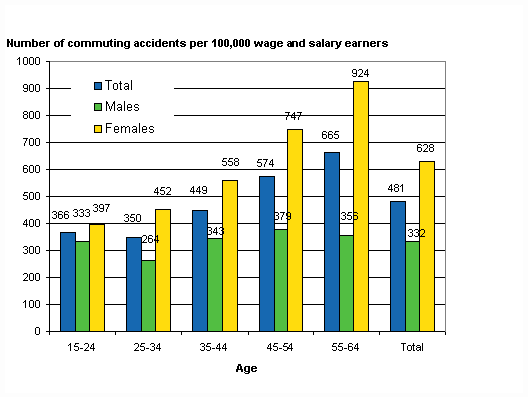
Most commuting accidents occur when walking or cycling: more than six out of ten (62%) of those injured in commuting accidents were walking and good one-fifth (22%) were cycling when injured. The differences between men and women in commuting accidents by mode of travel are not large: women get injured slightly more often than men when walking, while men have more passenger car accidents than women (Figure 9). It is not possible to take into account in the statistics the differences between women and men in their frequency of using a bicycle or a car on the journey between home and work.
Figure 9. Wage and salary earners' commuting accidents by mode of travel and gender in 2008
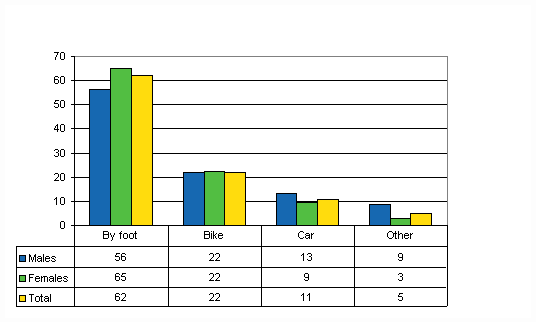
When considering the modes of travel it is natural that the most common type of accident is falling, slipping or stumbling. In 2008, nearly four out of five (79%) of all commuting accidents resulted from falling or slipping. The second most common type of accident is ’collision with a car’ Some 10 per cent of all commuting accidents resulted from a collision with a car (Table 10).
Table 10. Wage and salary earners’ commuting accidents by gender and type of accident in 2008
| Type of accident | Total | Males | Females | |||
| N | % | N | % | N | % | |
| Total | 10 684 | 100 | 3 649 | 100 | 7 035 | 100 |
| Falling, slipping or stumbling | 8 411 | 78,7 | 2 722 | 74,6 | 5 689 | 80,9 |
| Stepping on objects | 57 | 0,5 | 26 | 0,7 | 31 | 0,4 |
| Driving off the road or car falling over | 577 | 5,4 | 257 | 7,0 | 320 | 4,5 |
| Collision with a car | 1 051 | 9,8 | 424 | 11,6 | 627 | 8,9 |
| Collision with a bicycle, moped, etc. | 166 | 1,6 | 49 | 1,3 | 117 | 1,7 |
| Collision with a track-going vehicle | 3 | 0,0 | 1 | 0,0 | 2 | 0,0 |
| Violence | 26 | 0,2 | 8 | 0,2 | 18 | 0,3 |
| Others | 393 | 3,7 | 162 | 4,4 | 231 | 3,3 |
Most of the injuries caused by commuting accidents were minor, often caused by falling. In more than four cases out of ten, the victim’s injuries were diverse dislocations of joints, sprains and strains (Table 11). The injured body parts were often the extremities (Table 12).
Table 11. Wage and salary earners' commuting accidents by type of injury in 2008
| Type of Injury (ESAW) | Total | Males | Females | |||
| N | % | N | % | N | % | |
| Total | 10 684 | 100 | 3 649 | 100 | 7 035 | 100 |
| 010 Wounds and superficial injuries | 1 154 | 10,8 | 370 | 10,1 | 784 | 11,1 |
| 020 Bone fractures | 2 205 | 20,6 | 731 | 20,0 | 1 474 | 21,0 |
| 030 Dislocations, sprains and strains | 4 623 | 43,3 | 1 657 | 45,4 | 2 966 | 42,2 |
| 040 Traumatic amputations (Loss of body parts) | 4 | 0,0 | 4 | 0,1 | — | — |
| 050 Concussions and internal injuries | 2 286 | 21,4 | 743 | 20,4 | 1 543 | 21,9 |
| 060 Burns, scalds and frostbites | 6 | 0,1 | — | — | 6 | 0,1 |
| 070 Poisonings and infections | 6 | 0,1 | 3 | 0,1 | 3 | 0,0 |
| 090 Effects of sound, vibration and pressure | — | — | — | — | — | — |
| 110 Shocks | 9 | 0,1 | 2 | 0,1 | 7 | 0,1 |
| 120 Multiple injuries | 165 | 1,5 | 48 | 1,3 | 117 | 1,7 |
| 999 Other specified injuries not included under other headings | 70 | 0,7 | 25 | 0,7 | 45 | 0,6 |
| 000 No information | 156 | 1,5 | 66 | 1,8 | 90 | 1,3 |
Table 12. Wage and salary earners' commuting accidents by gender and injured body part in 2008
| Part of Body Injured (ESAW) | Total | Males | Females | |||
| N | % | N | % | N | % | |
| Total | 10 684 | 100 | 3 649 | 100 | 7 035 | 100 |
| 10 Head | 378 | 3,5 | 112 | 3,1 | 266 | 3,8 |
| 20 Neck | 543 | 5,1 | 195 | 5,3 | 348 | 4,9 |
| 30 Back, spine | 877 | 8,2 | 371 | 10,2 | 506 | 7,2 |
| 40 Torso, internal organs | 769 | 7,2 | 354 | 9,7 | 415 | 5,9 |
| 50 Upper extremities | 3 133 | 29,3 | 1 030 | 28,2 | 2 103 | 29,9 |
| 60 Lower extremities | 3 807 | 35,6 | 1 239 | 34,0 | 2 568 | 36,5 |
| 70 Entire body or several body parts | 1 071 | 10,0 | 307 | 8,4 | 764 | 10,9 |
| 99 Others | 21 | 0,2 | 6 | 0,2 | 15 | 0,2 |
| 00 Data missing | 85 | 0,8 | 35 | 1,0 | 50 | 0,7 |
Self-employed persons’ accidents at work
This section focuses on the accidents at work of farmers and other self-employed persons. Occupational accidents of self-employed persons (excl. farmers) were separated in the occupational accident statistics from wage and salary earners’ accidents at work for the first time in 1995. Earlier, accidents of self-employed persons were included as such in the occupational accidents of wage and salary earners. When examining the figures on self-employed persons’ accidents at work it must be noted that accident insurance is voluntary for self-employed persons, and not all of them are insured. Therefore, the distribution of self-employed persons’ accidents at work according to different background variables (age, occupation, industry) also illustrates in which occupations and sectors more self-employed persons are insured than usual.
In Finland most farmers live on their farms, which makes it impossible to separate accidents at work and commuting accidents from each other. In this publication all accidents having occurred to farmers in their work are called accidents at work. The data on farmers’ accidents at work are based on the data obtained from the Farmers’ Social Insurance Institution (MELA).
Apart from a full-time and working age farmer, the insured can be a pensioner, an under 18-year-old family member or a person practising part-time agriculture, game or reindeer husbandry or fishery. The number of farmers has decreased steadily during the past few years. At the end of 2008 there were 84,063 farmers insured by the Farmers’ Social Insurance Institution, which is about 2,500 fewer than one year previously and over 28,000 fewer than in 1999.
Farmers’ accidents at work decreased
The changes in the numbers of farmers are also visible in the numbers of their accidents at work. MELA paid to farmers compensation for a total of 5,246 accidents at work that had occurred in the course of 2008. The figure is down by around 550 cases from the previous year. There were a total of 4,453 occupational accidents leading to disability of at least four days, while in the previous year the respective figure was 4,759 (-6.4%). The number of farmers’ accidents at work has been falling throughout the past eight years, the year 2005 excluded (Figure 10). The accident peak in 2005 could in part be the result of the introduction that year of the full-cost responsibility system of patient care.
Figure 10. Farmers’ non-fatal accidents at work with at least 4 days’ absence in 2000–2008
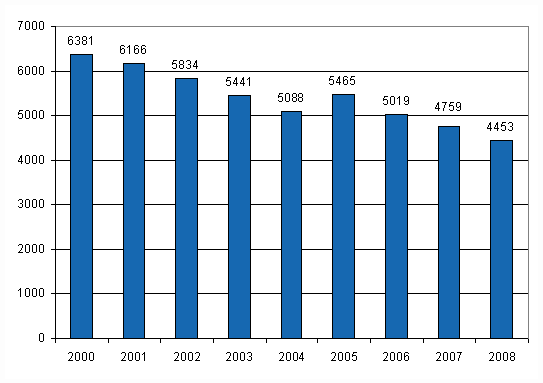
Farmers’ risk of death at work diminished slightly
Of all the farmers’ accidents at work for which compensation was paid in 2008 seven were fatal, whereas in the previous year eight farmers died as a result of an accident at work. All the farmers who died in accidents at work were men. Of all the fatal accidents at work of farmers in 2000-2008 only one occurred to a woman. This took place in 2005. Figure 11 presents the accident incidence rates of farmers from 2000 to 2008 with regard to both deaths at work and accidents leading to disability of at least four days. The figure shows that the risk of death at work varies strongly in different years. In 2008, 8.2 per 100,000 insured farmers died, while the corresponding ratio was 9.2 in 2007 and 5.6 in 2006. The year 2000 was the darkest in the near past; a total of 12.9 per 100,000 insured farmers died in accidents at work.
An examination of the time series reveals that farmers’ risk of fatal accidents at work has fallen by nearly one-fifth during 1999-2008. This becomes clear if we compare two five-year periods with each other. In the 1999-2003 period, farmers had 52 fatal accidents at work, which is an average of 9.9 fatal accidents per 100,000 farmers per year. In the 2004-2008 period, a total of 37 farmers died in accidents at work, which amounted to an annual average of 8.3 fatal accidents per 100,000 farmers.
Figure 11. Farmers’ accident rates in 2000–2008
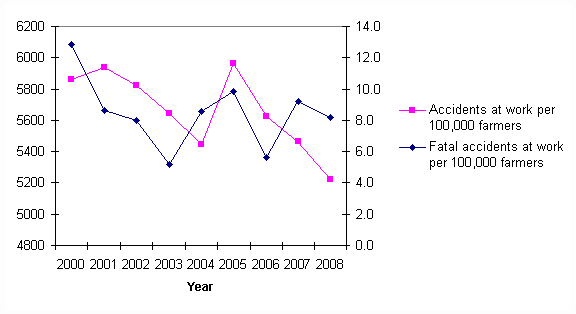
Table 13 compares the incidence rate of accidents leading to the death of the farmer with the riskiest industries among wage and salary earners in 2008. Because the majority of the persons who die in accidents at work are usually men, their accident incidence rate is given separately. The figures indicate that the work of male farmers was the most dangerous. Of them, a total of 12.4 per 100,000 insured farmers died in accidents at work in 2008. In 2007 the corresponding figure was 14.0.
In 2008, the riskiest industry for wage and salary earners was transport, storage and communication. For men in this industry the risk of death at work was 5.2 per 100,000 insured wage and salary earners. The second most risky industry for wage and salary earners was construction. In 2008, a total of 3.7 men per 100,000 insured wage and salary earners lost their lives in the construction industry.
Table 13. Farmers’ fatal accidents at work compared with wage and salary earners’ fatal accidents in high risk branches of industry per 100,000 farmers or wage and salary earners in 2007–2008
| Year 2007 | Year 2008 | |||
| Total | Males | Total | Males | |
| Farmers | 9,2 | 14,0 | 8,2 | 12,4 |
| Wage and salary earners | 1,7 | 3,0 | 1,4 | 2,6 |
| Industry | 1) | 1) | 0,8 | 1,0 |
| Construction | 1) | 1) | 3,4 | 3,7 |
| Transport, storage and communication | 1) | 1) | 3,8 | 5,2 |
Among farmers, the proportion of minor accidents at work resulting in disability of less than four days has stayed roughly unchanged in the past few years, and been under 10-15 per cent of all compensated accidents. Nearly every third (31%) accident at work was a so-called serious accident, i.e. caused disability lasting longer than one month (Appendix Table 5). In the following the focus will be on those accidents at work that resulted in absence of at least four days.
Farmers’ risk of accidents increases with age
In 2008, there were 5,220 accidents at work per 100,000 insured farmers, which was slightly fewer than in 2007 (5,465). However, farmers’ risk of accidents is still clearly higher than that of wage and salary earners and distinctly higher for men than for women: men had 6,021 and women 3,670 accidents at work per 100,000 insured farmers (Figure 12). This difference between the genders is partly explained by the fact that in farming men conventionally undertake the kind of work in which accidents are common. Such work includes, e.g. construction work and tasks related to the use and maintenance of machinery and equipment.
Figure 12. Farmers’ accident at work per 100 000 insured by gender and age in 2008
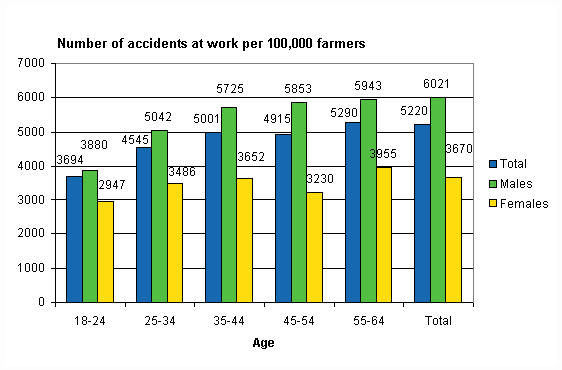
More than six out of ten (62%) of farmers’ accidents occur to over 45-year-olds. In 2008, the relative number of accidents at work was the highest in the age group of over 55-year-olds (5,943). The respective rate in the age group of under 25-year-olds was 3,694 in 2008, having been 6,045 in 2007. The annual variation in their accident risk can be quite large, as the number of insured farmers belonging to the youngest age group is fairly low.
Most accidents occur in animal husbandry
The proportion of accidents occurring in various animal husbandry tasks was similar to their proportion one year previously, or 45 per cent of all accidents at work (Table 14). Especially women fell victims to accidents at work when tending cattle; more than three in four (77%) of women’s accidents at work took place in animal husbandry. The respective proportion among men was slightly over one-third (35%). The second highest number of accidents (23%) occurred in other agricultural and forestry work, including tasks such as installation and maintenance of machinery and equipment. Less than one in five (15%) of accidents at work occurred while performing other tasks related to farming. However, no actual conclusions can be drawn from the available statistical data of the dangerousness of work in different areas because then the amount of working hours spent on different tasks should also be known. The classification of the variables describing the stages of work is national. The classification used by MELA is more detailed than the ESAW variables illustrating the working process.
Table 14. Farmers' accidents at work by type of work and gender in 2008
| Total | Males | Females | ||||
| N | % | N | % | N | % | |
| Total | 4 453 | 100 | 3 386 | 100 | 1 067 | 100 |
| Farming work | 654 | 14,7 | 566 | 16,7 | 88 | 8,2 |
| Animal husbandry | 1 987 | 44,6 | 1 169 | 34,5 | 818 | 76,7 |
| Forest work | 393 | 8,8 | 366 | 10,8 | 27 | 2,5 |
| Construction work | 265 | 6,0 | 248 | 7,3 | 17 | 1,6 |
| Other agricultural and forestry work | 1 021 | 22,9 | 912 | 26,9 | 109 | 10,2 |
| Other work | 133 | 2,9 | 125 | 3,5 | 8 | 0,7 |
In roughly one-third of the cases (37 %) the deviation leading to an accident of the farmer was falling, jumping, stumbling or slipping. Violence, a shocking situation or a non-standard practice (e.g. neglected protection) was the reason behind the accident in one-fourth of the cases (23 %).
Farmers most often injured as a consequence of horizontal or vertical impact with or against a stationary object
Horizontal or vertical impact with or against a stationary object was the most common mode of injury for farmers. In three cases out of ten (32%) the person was injured due to horizontal or vertical impact with or against the floor, ground or similar (Figure 13). Women farmers were pushed or kicked by an animal more often than men, as every fourth (23%) of women farmers’ accidents was caused by an animal. Every tenth (11%) male farmer injured in an accident at work was hurt by an animal bite, kick or similar.
Figure 13. Farmers' accidents at work by contact-mode of injury (ESAW) and gender in 2008
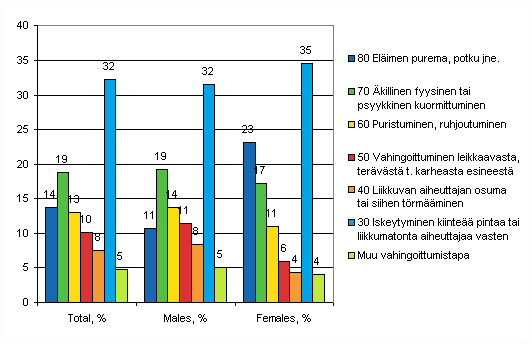
In one in four (25%) of farmers’ accidents at work the material agent was living organisms and human-beings (Figure 14). In all probability most of these farmers' accidents were caused by animals. Various buildings, structures and surfaces were the material agents in every fifth accident (22%). Physical phenomena and natural elements caused 11 per cent of the accidents at work. The Farmers’ Social Insurance Institution collects data on the material agents using the ESAW classification.
Figure 14. Farmer's accidents by material agent of contact-mode of injury in 2008
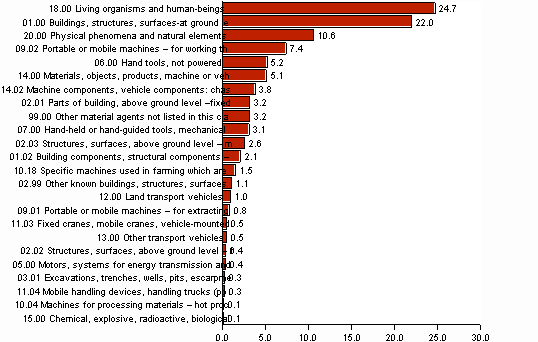
In 2008, a total of 41 per cent of farmers’ injuries sustained in accidents at work were various kinds of dislocations, sprains and strains. Wounds and superficial injuries form another large group of injuries (29%). Seventeen per cent of all injuries to farmers were bone fractures. There were no significant differences in the distributions of men’s and women’s injuries: men’s injuries were more often wounds and superficial injuries, while women’s injuries were different kinds of sprains and strains (Figure 15).
Figure 15. Farmers' accidents at work by type of injury and gender in 2008
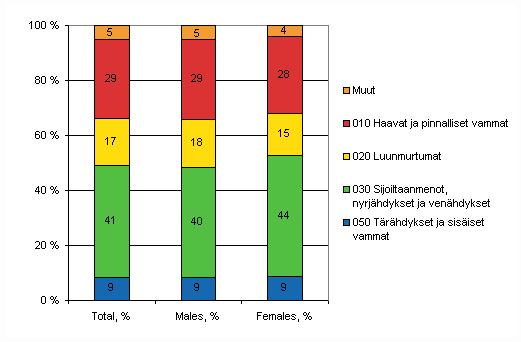
About seven out of ten (71%) of all the accidents at work which occurred to farmers concerned extremities (Figure 16). Women injured their lower extremities more often than men did, while men's injuries concerned their upper extremities. Injuries to lower extremities most often involved knees and those to upper extremities palms or fingers.
Figure 16. Farmers' accidents at work by injured body part and gender in 2008
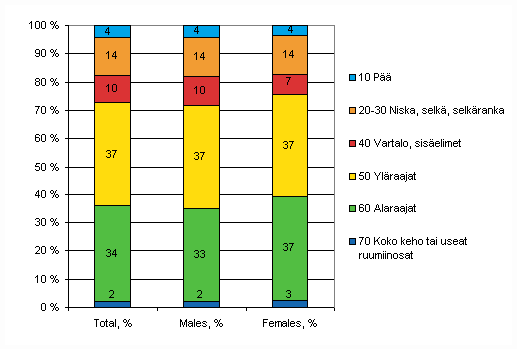
Self-employed persons most often injured in manufacturing occupations and building construction
In 2008, insurance companies paid self-employed persons compensation for a total of 5,936 accidents at work. This also includes accidents on which compensation was paid only for medical treatment expenses. The proportion of these accidents at work that led to absence from work of less than four days was about 40 per cent of all self-employed persons’ accidents. One year previously compensation was paid for 5,659 accidents. The data concern self-employed persons other than farmers.
In 2008, self-employed persons suffered 3,413 accidents at work that led to disability lasting at least four days. This is 118 cases more than in the year before. The gender distribution of accidents at work is the same among self-employed persons as among wage and salary earners: the vast majority (86%) of the accidents of self-employed persons occurred to men. The age distribution of the victims of accidents at work show that around six out of ten (61%) of self-employed persons’ accidents occurred in the age group of 35 to 54-year-olds (Table 15).
Table 15. Self-employed person's accidents at work by gender and age in 2008
| Age | Total | Males | Females | |||
| N | % | N | % | N | % | |
| Total | 3 413 | 100 | 2 934 | 100 | 479 | 100 |
| 15–24 | 48 | 1,4 | 38 | 1,3 | 10 | 2,1 |
| 25–34 | 465 | 13,6 | 393 | 13,4 | 72 | 15,0 |
| 35–44 | 940 | 27,5 | 839 | 28,6 | 101 | 21,1 |
| 45–54 | 1 148 | 33,6 | 987 | 33,6 | 161 | 33,6 |
| 55–64 | 752 | 22,0 | 632 | 21,5 | 120 | 25,1 |
| Others | 60 | 1,8 | 45 | 1,5 | 15 | 3,1 |
Similarly to wage and salary earners, self-employed persons also had the highest numbers of accidents at work in manufacturing occupations and building construction. Examined by industry, self-employer persons’ risk industries are also mostly the same as those of wage and salary earners. The most dangerous industries are construction, and transport, storage and communication. The variables describing the causes and consequences of self-employed persons’ accidents at work are examined more closely in Appendix Tables 6 to 10.
Source: Occupational accident statistics 2008, Statistics Finland
Inquiries: Arto Miettinen (09) 1734 2963, tyotapaturmat@stat.fi
Director in charge: Riitta Harala
Updated 30.11.2010
Official Statistics of Finland (OSF):
Occupational accident statistics [e-publication].
ISSN=1797-9544. 2008,
Wage and salary earners’ accidents at work
. Helsinki: Statistics Finland [referred: 16.4.2024].
Access method: http://www.stat.fi/til/ttap/2008/ttap_2008_2010-11-30_kat_001_en.html

